Contents
White flowers are one of the best ways to tie a garden together and add brightness to the landscape. They offer a stark contrast to the dark green and browns of most gardens and help to divide sections. They can also provide balance to areas that may not have flowers at all.
With that being said, there are so many white flowering plants, that it can be completely confusing to figure out which one may fit your garden design, or your climate. The good news is that white flowers grow in pretty much every climate imaginable, so there’s many different flower types to choose from.
Whether it’s a mat, bush, shrub, or tree, white flowers can easily become the centerpiece of the garden. In this extensive list, you’ll find all of our favorites and learn more about them so that you can choose the best ones for your garden and know how to take care of them. Let’s jump in and look at our favorites, with names and pictures of each!
Allium

Scientific Name: Allium
- Plant Type: Perennial
- Geographic Origin: Central Asia
- Plant Size: 6 inches to 3 feet
- Sun Exposure: Full Sun
- Plant Zone: 3 to 8
White allium is in the same family as onion and garlic plants. Sometimes referred to as the White Giant, this plant can grow up to four feet tall and produces globes measuring six to eight inches in diameter.
These perennial blooms like full sun exposure and bloom from late spring to early summer. Plant them in the fall in clusters of ten to fifteen for the best effect.
Allium grows well in chalky, sandy, and clay-filled soils and can withstand droughts and deer and rabbit-filled environments. They attract butterflies.
Amaryllis

- Plant Type: Perennial
- Geographic Origin: South Africa
- Plant Size: 4-10inches
- Sun Exposure: Partial Shade
- Plant Zone: 8 to 9
Scientific Name: Amaryllis
The amaryllis flower, specifically the Alfresco variety, is a gorgeous, full plant that grows five to eight flowers per stem and two to three stems per bulb. The plant usually reaches twelve to eighteen inches and blooms for several weeks to several months.
Amaryllis are hardy perennial flowers that can stick around for a whopping seventy-five years. They do well in chalky, clay, sandy, and loam soils and are very easy to care for.
Amaryllis bloom anywhere from late December to the end of June and should be planted between October and May. They usually flower six to eight weeks after they’re planted.
Angel’s Trumpet

Scientific Name: Brugmansia
- Plant Type: Nightshade
- Geographic Origin: South America
- Plant Size: 10–36feet
- Sun Exposure: Full Sun
- Plant Zone: 8 to 11
Angel’s trumpet is a shrub tree that produces eight to ten-inch hanging flowers. The plant generally stands at ten to fifteen feet high and offers a sweet fragrance.
This plant does well in chalky, loam, clay, and sandy soil and doesn’t require special care or extra watering. Angel’s trumpet loves the sun and doesn’t do well in freezing temperatures.
This plant needs lots of fertilization during the growing season and is resistant to most diseases. It is also toxic if ingested.
Angelonia
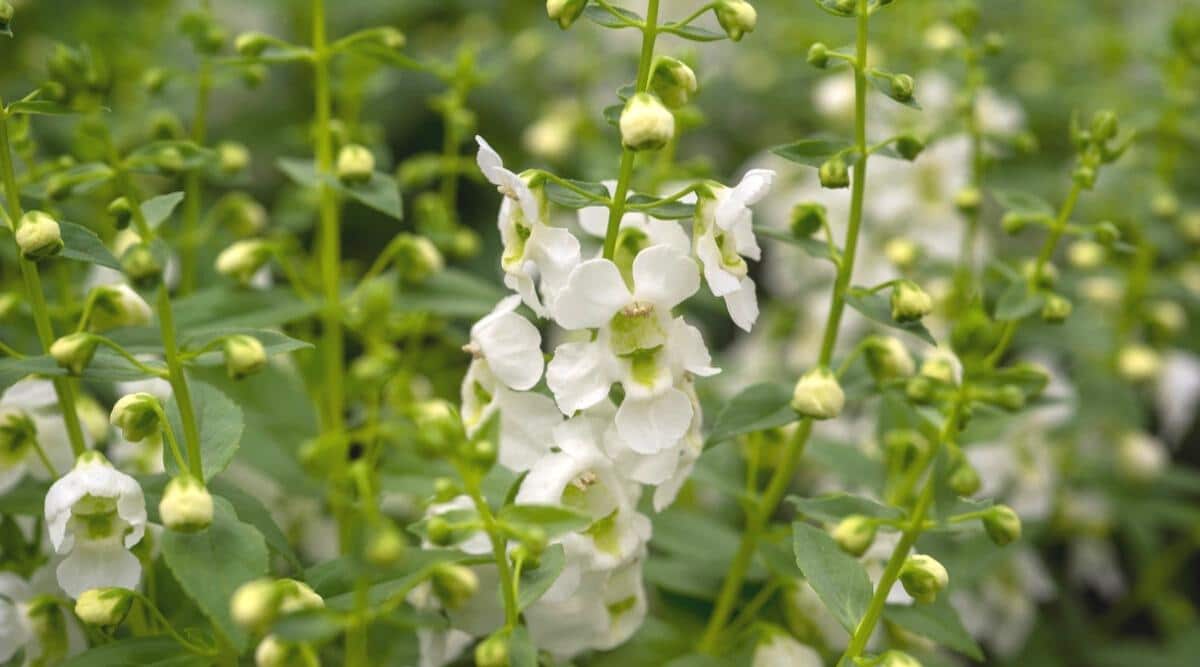
Scientific Name: Angelonia
- Plant Type: Annual
- Geographic Origin: Central and South America
- Plant Size: 12-18 inches tall
- Sun Exposure: Full Sun
- Plant Zone: 9 to 11
The angelonia, sometimes called angelface or summer snapdragon is a tender perennial that needs very little water and even less maintenance. It grows well in the usual chalky, clay, or sandy soil and loves sunlight.
Angelonia grows thirty to forty inches tall and about twelve to eighteen inches wide. It is self-cleaning, rarely attracts pests or disease, and can be propagated through cuttings.
This plant grows from late spring through fall. It does well in gardens, pots, indoors, and as cuttings. The flowers are quite small, so it makes for a good space filler.
Arabian Jasmine

Scientific Name: Jasminum Sambac
- Plant Type: Perennial Shrub
- Geographic Origin: Bhutan and India
- Plant Size: 1.6-9.8 ft
- Sun Exposure: Full Sun
- Plant Zone: 8 to 11
Arabian jasmine is a stunning plant that offers a bold and enticing fragrance. It is a scrambling evergreen that can twine with support and grows six to ten feet tall and wide.
The many white flowers grow in clusters of three to twelve and can last the whole summer or longer in warmer climates. Their flowers also fade to pink with maturity.
Arabian jasmine likes full and partial sun and loam soils. It requires little maintenance but needs good drainage. It rarely has pests and can be pruned and shaped.
Astilbe
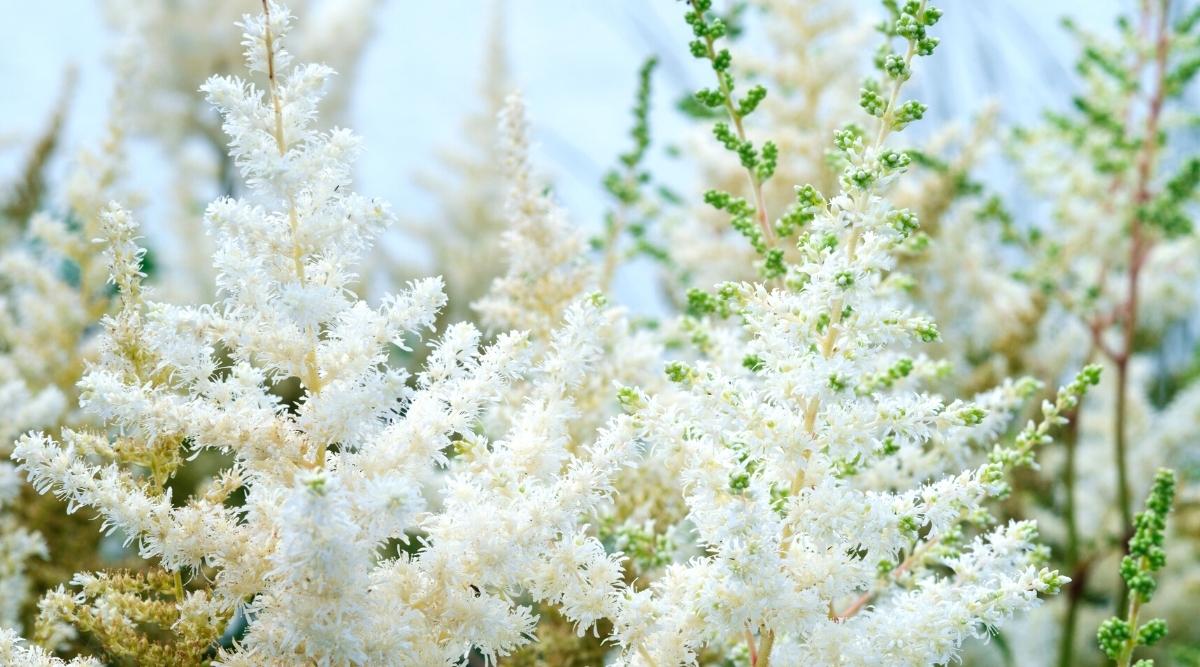
Scientific Name: Astilbe
- Plant Type: Perennial
- Geographic Origin: North America, Asia
- Plant Size: 6-24 in tall, 6 in – 5 ft spread
- Sun Exposure: Partial Shade to Full Shade
- Plant Zone: 3 to 8
Astilbes are fantastical flowers that grow in huge clusters. They do well in any level of sun, can withstand deer, rabbits, and wet soil, require lots of water and good drainage, and like loam soil.
They start blooming in early summer and last a couple of months. Astilbes are perennials that grow well in shade, and can grow up to twenty-eight inches tall. This allwos them to offer dense, rich foliage all season long.
The flower stalks fade into a rich caramel as they die off and add interest throughout winter.
Bacopa
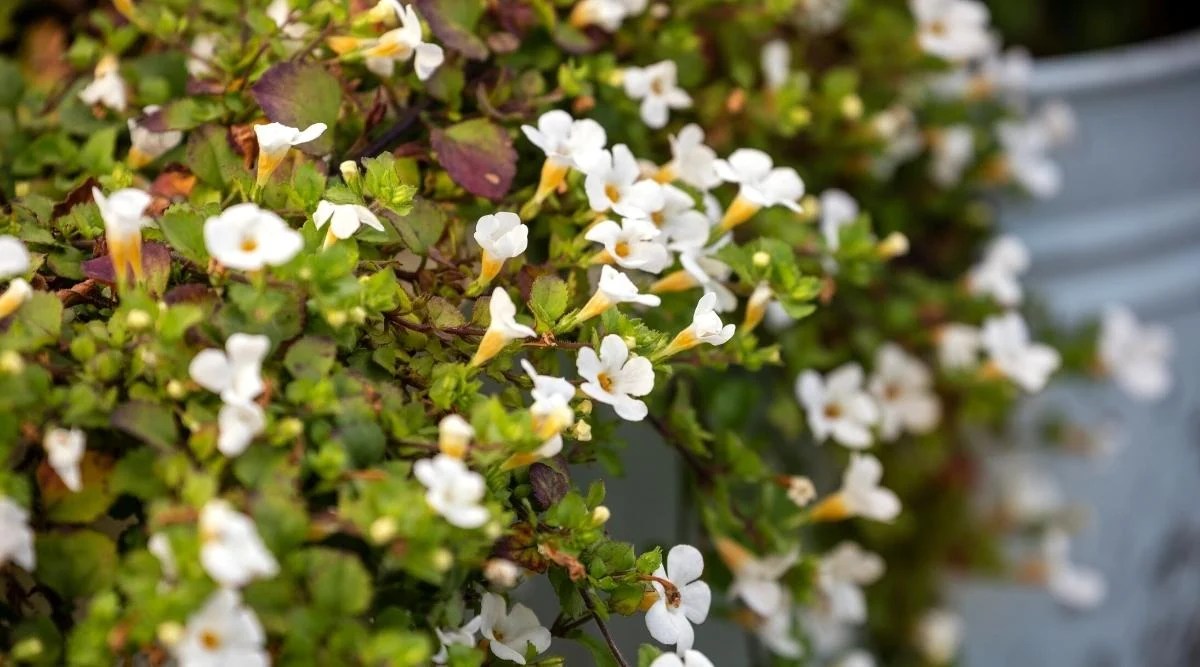
Scientific Name: Bacopa Monnieri
- Plant Type: Perennial
- Geographic Origin: Native to the wetlands of Southern and Eastern India, Australia, Europe, Africa, Asia, and North and South America
- Plant Size: 12-36 intall
- Sun Exposure: Partial Shade to Full Shade
- Plant Zone: 8 to 11
Bacopa, or water hyssop, is a semi-aquatic perennial that forms a large, creeping mat. This plant grows twelve to thirty-six inches tall and spreads anywhere from twelve to forty-eight inches out. It blooms from mid-spring to the end of fall or year-round in warmer climates.
Bacopa loves water and does well in full and partial sun. It grows fast and looks nice in the garden or hanging baskets. It rarely gets diseased or attracts pests and may have antioxidant properties that can be used in medicine.
Butterfly Bush

Scientific Name: Buddleja
- Plant Type: Herbaceous Perennials
- Geographic Origin: Central China
- Plant Size: 1-9 feet
- Sun Exposure: Full Sun
- Plant Zone: 5 to 10
Butterfly bush is a shrub that loves full sun exposure and requires very little outside care. It grows around three to five feet wide and tall and flowers from mid-summer to the end of fall.
While this plant is invasive in some areas, it also attracts butterflies and hummingbirds and does well against deer, rabbits, and drought.
Butterfly bush has a strong, sweet smell and fits perfectly in forest and cottage gardens. Pruning in mid-spring and removing spent flowers can help encourage further blooms.
Calla Lily

Scientific Name: Zantedeschia Aethiopica
- Plant Type: Herbaceous Perennials
- Geographic Origin: Southern Africa
- Plant Size: 2.0–3.3 ft tall
- Sun Exposure: Full Shade to Partial Shade
- Plant Zone: 8
Calla lilies are semi-evergreen perennials that flower from late spring to early summer. They stand at two to three feet tall and do best in partial to full sun. They need lots of water but little outside care and prefer clay and loam-type soils.
Calla lilies like very wet soil and warmer climates. They do better with more shade in hotter areas. The sap can irritate skin and eyes, and the plant should not be ingested.
These plants do well in gardens, pots, and indoors and are very easy to grow.
Camellia

Scientific Name: Camellia Japonica
- Plant Type: Shrub, Evergreen
- Geographic Origin:
- Plant Size: 6-14 feet
- Sun Exposure: Full Sun to Partial Shade
- Plant Zone: 7 to 9
Camellias are slow-growing shrubs that prefer shadier environments. They stand at only six to eight inches and spread just as far. The flowers are three to four inches wide and harbor hundreds of elegant petals.
Camellias don’t require much maintenance and like clay, loam, and sandy soil. Plant them in sheltered areas away from cold, harsh winds and bright, hot sun. Avoid morning sun and basic soils.
Camellias can attract aphids, scale insects, and vine weevils and need to be pruned after flowering.
Canada Anemone
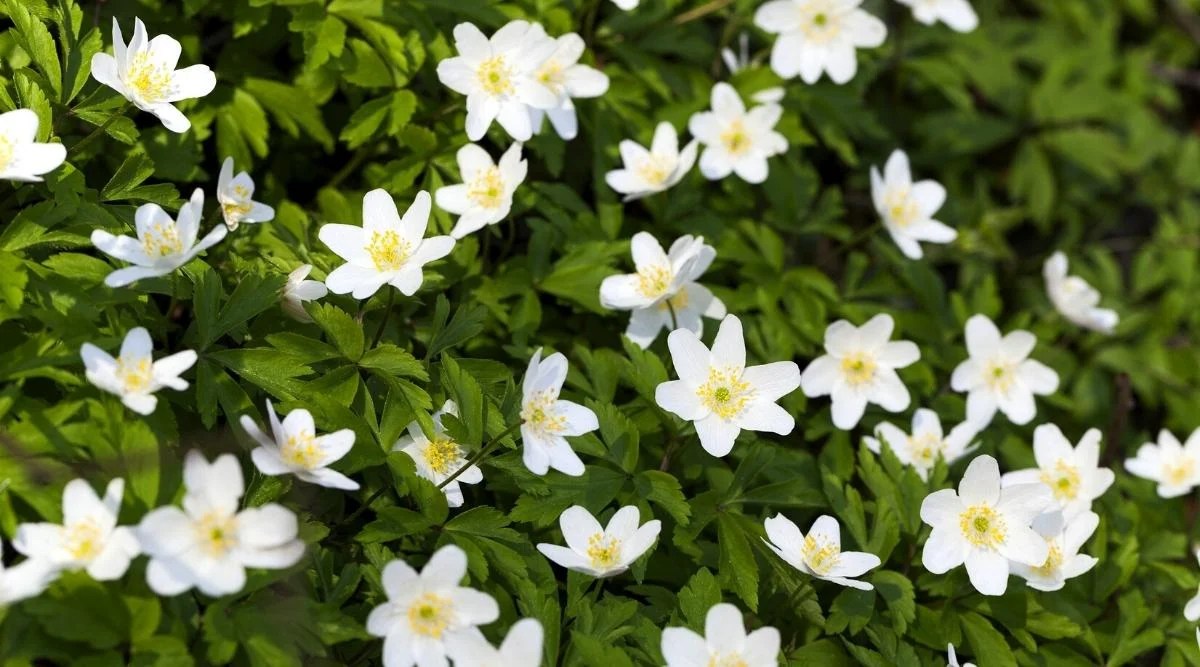
Scientific Name: Anemone Canadensis
- Plant Type: Herbaceous Perennial
- Geographic Origin: North America
- Plant Size: 12-24 in.tall
- Sun Exposure: Partial Sun, Shade
- Plant Zone: 3 to 8
Canada Anemone is a hardy perennial easily grown in chalky, clay, loam, or sandy soil. It requires very little care but a fair amount of water.
The Canada anemone is usually twelve to twenty-four inches tall and spreads twenty-four to thirty inches wide. It likes partially sunny or shady areas and wet but well-drained soil.
This plant grows well by streams, ponds, and in meadows and is sometimes called the meadow anemone. It doesn’t often attract disease or pests but can form mildew and acquire caterpillars, flea beetles, and slugs.
Candytuft
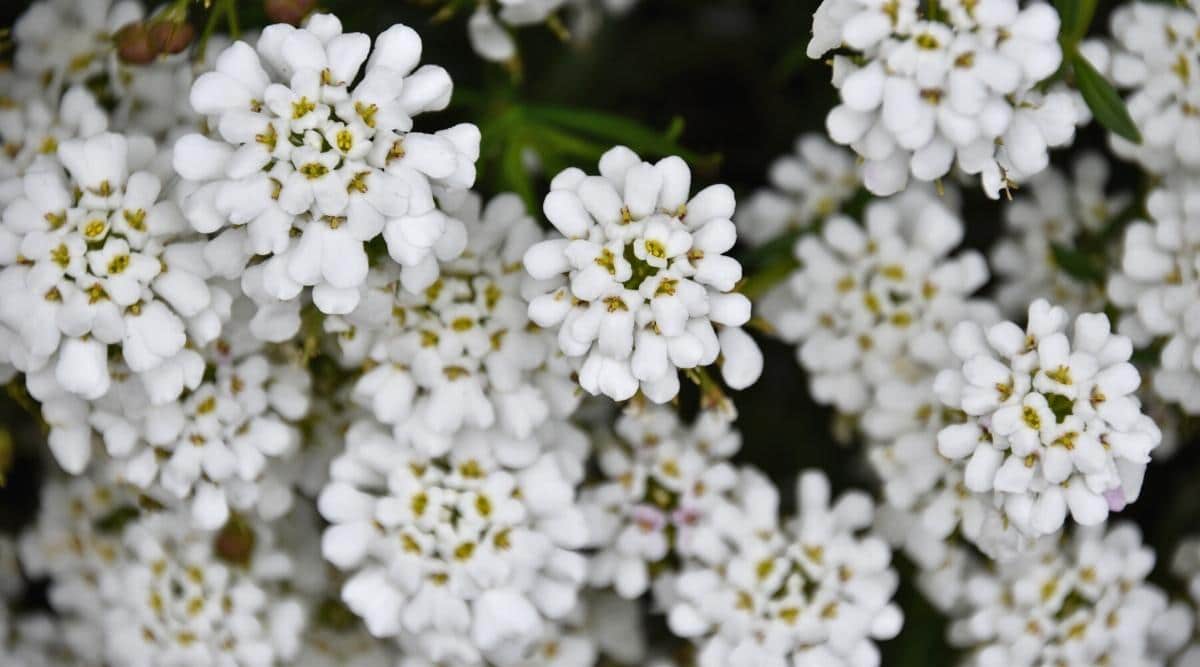
Scientific Name: Iberis Sempervirens
- Plant Type: Perennial
- Geographic Origin:
- Plant Size: 12–18 in.tall, 12-16 in. wide
- Sun Exposure: Full, Partial Sun
- Plant Zone: 3 to 9
Candytuft is a stout, bushy plant that stands roughly six to twelve inches tall and twelve to eighteen inches wide. It is made up of clusters of small white flowers and dark green, evergreen leaves.
Candytuft blooms in spring until early summer and has very standard water and maintenance needs. It is a perennial and likes a lot of sun. As well, this plant enjoys wet but well-drained chalky, sandy, and loam soils. It is tolerant to deer, rabbits, and drought.
Maintain the plant by trimming back one-third after flowering is done.
Carnation

Scientific Name: Dianthus Caryophyllus
- Plant Type: Perennial
- Geographic Origin: Europe and Asia
- Plant Size: 6-18 in tall
- Sun Exposure: Full Sun, Partial Shade
- Plant Zone: 5 to 10
Carnations come in many varieties and colors including white. They can grow up to thirty inches high and are perennials. Carnations can be propagated from cuttings and flowers throughout summer.
This plant enjoys moist soil and plenty of sunlight and shouldn’t be overwatered. Carnations should be pruned after blooming.
Grow carnations in the garden, pots, or indoors.
Chrysanthemum
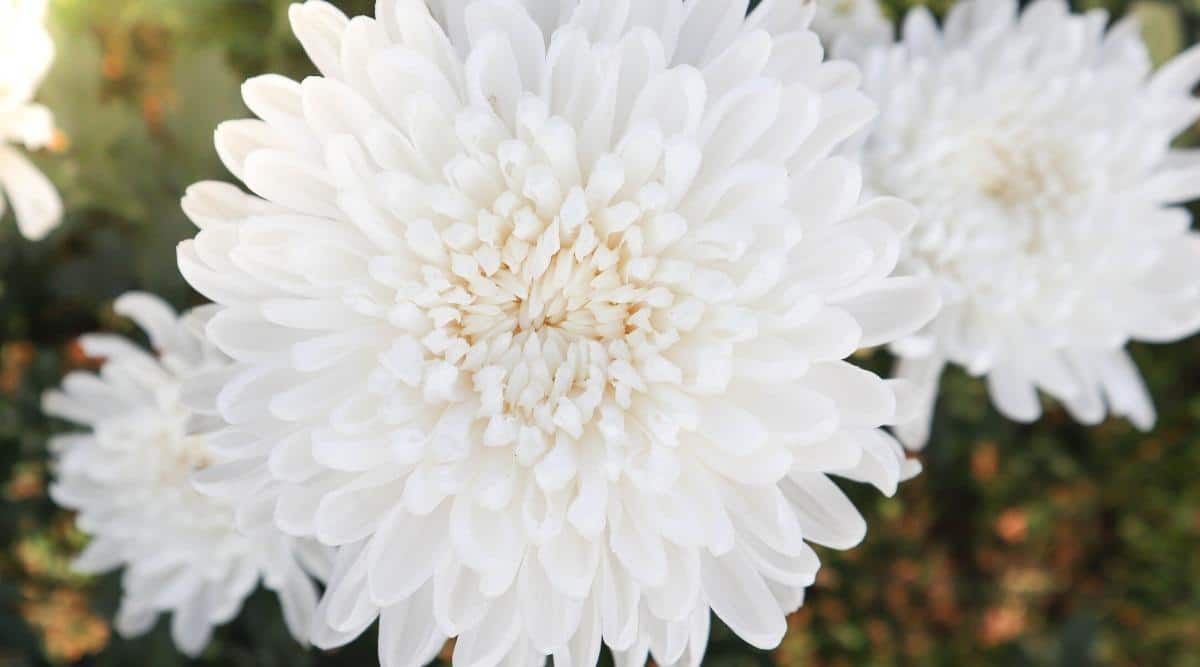
Scientific Name: Chrysanthemum
- Plant Type: Perennial
- Geographic Origin: Asia
- Plant Size: 1-3 feet
- Sun Exposure: Full Sun
- Plant Zone: 4 to 9
Chrysanthemums are bushy perennial flowers that contrast their dark leaves like no other. They stand rough six to sixteen inches high and spread ten to eighteen inches wide.
Chrysanthemums grow best with full sun and planted in moist clay, loam, or sandy soil with good drainage.
These flowers are about two inches in diameter, and there are many flowers per stem. With a bit of fertilizer, these flowers are easy to grow. Plant them in an area sheltered from strong winds and trim them as they grow to encourage the desired shape.
Clematis
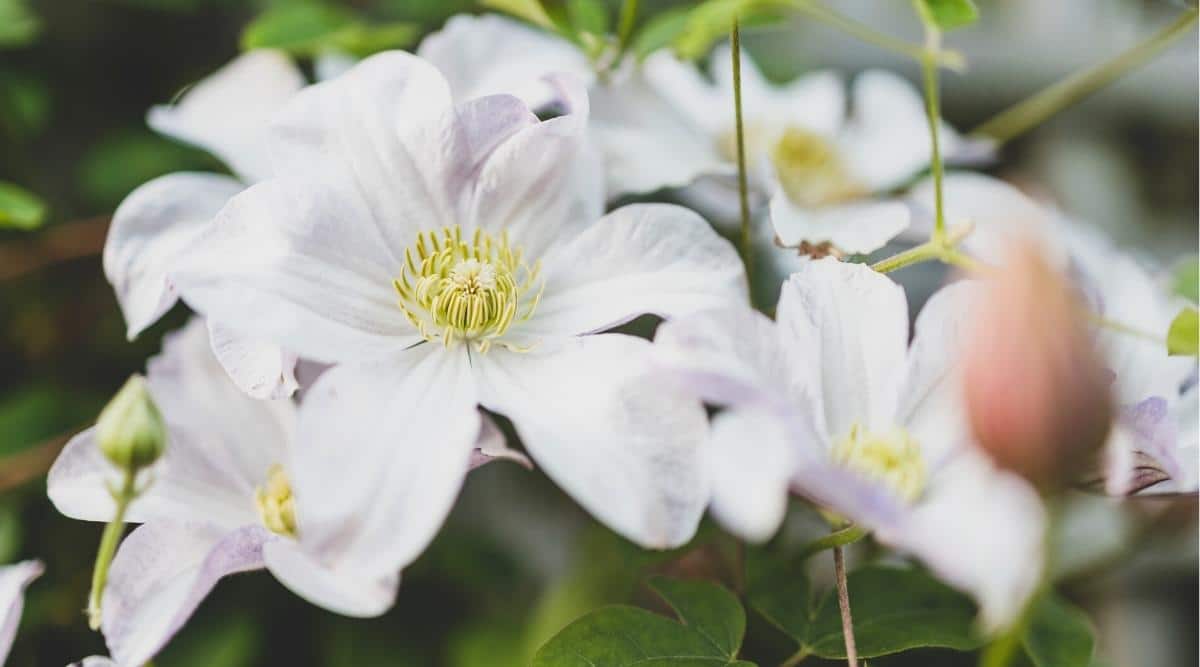
Scientific Name: Clematis
- Plant Type: Perennial Vine
- Geographic Origin: Japan and China
- Plant Size: 20 to 30 feet
- Sun Exposure: Full Sun to Partial Shade
- Plant Zone: 4 to 9
Clematises are beautiful climbing plants that can grow eight to ten feet in height and make flowers that are usually five to six inches in diameter. This plant requires very little maintenance and can grow in sandy, chalky, clay, or loam soil so long as there is enough water.
Clematises will bloom in late spring until fall, depending on the climate, and produce many vivid flowers.
The clematis is easy to grow and like partially shaded areas. The asagasumi variety is a particularly nice white strain.
Cosmos

Scientific Name: Cosmos Bipinnatus
- Plant Type: Annual
- Geographic Origin: Mexico
- Plant Size: 8 in-6 ft
- Sun Exposure: Full Sun
- Plant Zone: 2 to 11
Cosmos, or cupcake whites, are tall, spindly plants that grow between three and four feet tall. They love the sun and will grow in any soil type, so long as it is moist and has good drainage.
This variety of cosmos is invasive in some areas but produces a unique, bowl-shaped flower. Cosmos self-seed and can be prone to aphids, slugs, and gray mold.
These flowers will bloom throughout summer and into fall. They are annual flowers that need to replanted every year.
Daffodil

Scientific Name: Narcissus
- Plant Type: Perennial
- Geographic Origin: Europe, North America
- Plant Size: 6-30 in. tall
- Sun Exposure: Full or partial sun
- Plant Zone: 4 to 8
Daffodils are sun-loving flowers that enjoy well-drained yet moist soil. They bloom for only a short period in mid to late spring and should be planted in fall.
They are rabbit and deer resistant and require little maintenance. Daffodils grow to be about fourteen to sixteen inches tall and look best in groups or clusters. Daffodils should not be eaten and may irritate sensitive skin.
They are perennial bulbs. The flowers measure about four inches but come in many varieties and sizes.
Dahlia

Scientific Name: Dahlia
- Plant Type: Perennial (Zones 8-11); Annual
- Geographic Origin: South America, Mexico
- Plant Size: 2 feet to 7 feet
- Sun Exposure: Partial to Full Sun
- Plant Zone: 3 to 11
Dahlias are perennial bulbs that form dense flowers with hundreds of small petals. The flowers measure roughly four inches in diameter, and the plant itself reaches forty-eight inches. Dahlias will grow well in full sun exposure but should be kept out of harsh winds. They also need a consistent amount of water.
Dahlias attract butterflies and do well in sandy, loam, and clay-type soils. Plant in groups of five or so for the best visual appeal and dig up and store the bulbs overwinter in colder climates. There are many different varieties of white dahlia, so depending on what you want your white blooms to look like, there’s likely a dahlia that will match your style.
Daisy

Scientific Name: Bellis Perennis
- Plant Type: Herbaceous flowering perennial/biennial
- Geographic Origin: Northern Africa, Southwestern Asia, and Europe
- Plant Size: 4-6 in. tall
- Sun Exposure: Full Sun, Parial Sun
- Plant Zone: 4 to 8
The common daisy blooms in late spring through to mid-summer. They grow to a height of about four inches and come back every year.
Daisies will grow in almost any soil and take very little care to maintain. They love sunlight and need a consistent water source.
Taller and larger varieties are ideal for gardens and are equally simple to care for. Daisies are some of the least problematic plants and work well to fill space in any garden. Fertilizer helps promote better growth.
Delaware Valley White Azalea

Scientific Name: Rhododendron
- Plant Type: Evergreen shrub
- Geographic Origin: North America
- Plant Size: 5-25 ft tall
- Sun Exposure: Full sun to part shade
- Plant Zone: 4 to 8
The Delaware Valley white azalea is a gorgeous evergreen plant that makes near-translucent flowers. The plant grows three to four feet high and produces a potent fragrance.
These plants are easy to grow and require little care over their forty-year life span. It blooms throughout the summer and enjoys full or partial sun.
The Delaware Valley white azalea is not suited to colder climates, but other varieties fare better. Additionally, these flowers can have many diseases and pest issues, including aphids, caterpillars, lace bugs, crown rot, canker, and leaf gall.
Fan Flower
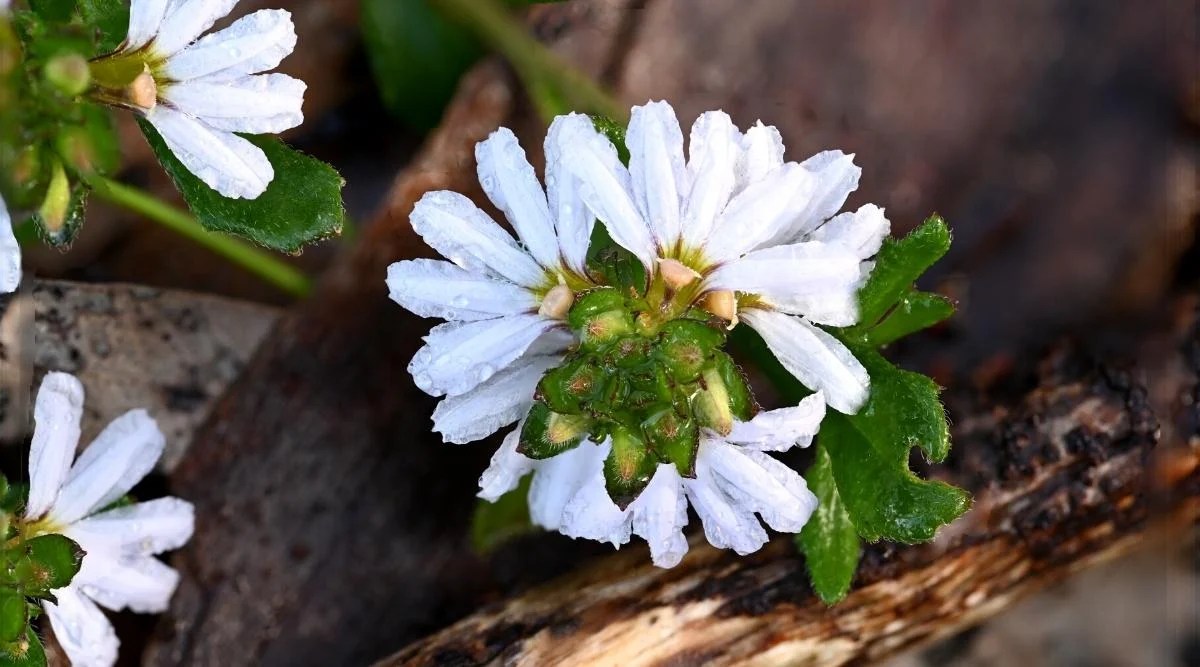
Scientific Name: Scaevola
- Plant Type: Evergreen Perennial/Shrub
- Geographic Origin: Australia
- Plant Size: 8-12 in tall
- Sun Exposure: Full, Partial
- Plant Zone: 9 to 11
The fan flower is a small, mat-forming shrub that can get as tall as twenty inches and spread out forty inches. It likes well-drained soil and partially shaded areas.
Fan flowers do best in open areas by bodies of water. They can tolerate sea spray and drought and generally don’t have problems with disease or pests.
Fan flowers bloom in the summer months and grow well in warmer, tropical climates. Prune then to maintain shape and propagate through cuttings.
Floristan White Liatris

Scientific Name: Liatris Spicata
- Plant Type: Herbaceous Perennial Flowering Plant
- Geographic Origin: Eastern North America
- Plant Size: 2-4 ft tall
- Sun Exposure: Full
- Plant Zone: 3 to 9
Floristan White Liatris is a special, grass-like perennial that forms tall stalks of white flowers. The plant usually reaches three to four feet and flowers from the bottom up over four weeks in summer.
This plant is famous for attracting bees, butterflies, hummingbirds, and other birds. The dried seed head provides food for birds in winter. It is deer and drought tolerant and enjoys full sun exposure. This plant is easily maintained and will grow in any soil type.
Floristan White Liatris is nearly disease and pest-free and grows well in wet gardens, meadows, and prairies. It also makes for lovely dried arrangements.
Foxglove
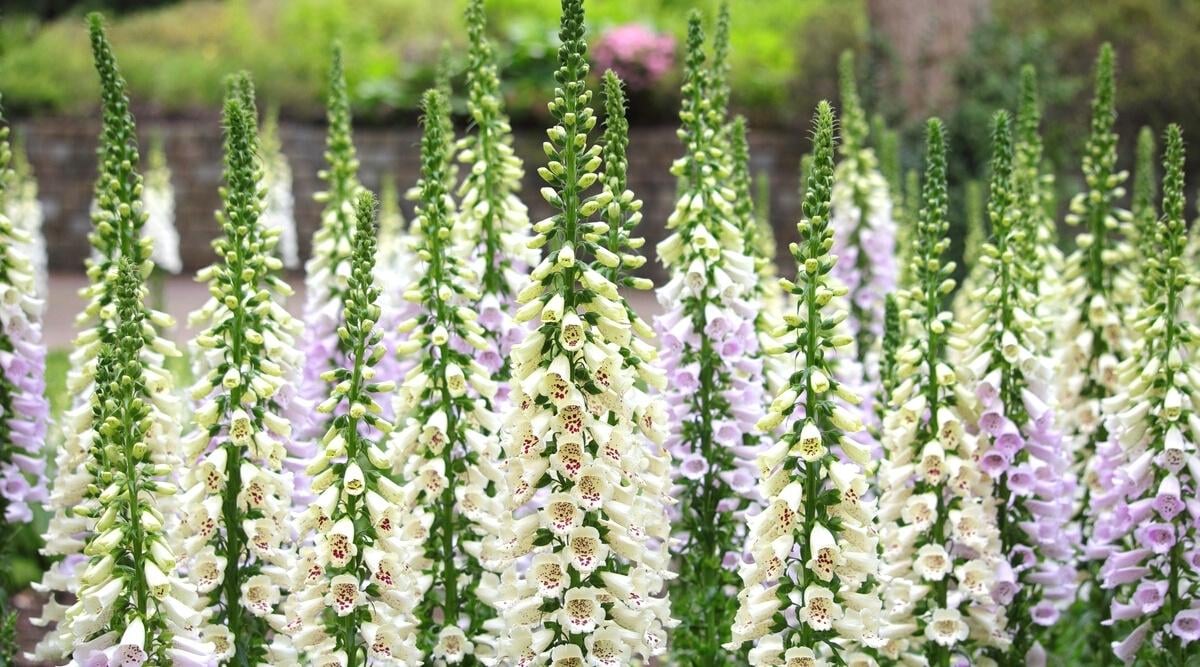
Scientific Name: Digitalis
- Plant Type: Biennial
- Geographic Origin: Europe, western Asia, and northwestern Africa
- Plant Size: 2-5 ft tall
- Sun Exposure: Full Sun to Partial Shade to Full Shade
- Plant Zone: 4 to 9
Foxglove is yet another tall plant that reaches three to four feet in height. It forms long bell-shaped flowers with dappled spots on the insides.
Foxglove loves the sun but does well with a bit of shade in warmer months. It takes very little maintenance and is resistant to deer, rabbits, and urban pollution. It also attracts butterflies, hummingbirds, and other birds.
Foxglove is invasive in some areas and should be planted in spring by seeds. Remove flowers after bloom to prevent excess seed spread. Foxglove may also be prone to aphids, eelworm, and leaf spots.
Gardenia

Scientific Name: Gardenia Jasminoides
- Plant Type: Evergreen Shrub
- Geographic Origin: Asia
- Plant Size: 3-8 ft
- Sun Exposure: Full Sun, Partial Sun
- Plant Zone: 7 to 10
Gardenias are shrub flowers that produce massive blooms of four to five inches in diameter.
They flower from late spring to early summer, and like clay, loam, and sandy soil.
They need a lot more maintenance than other plants, as they are prone to mildew, leaf spots, anthracnose, mold, scales, aphids, mealy bugs, and spider mites.
Gardenias like clay, loam, and sandy soil. The soil should also be moist and well-drained. They also need plenty of sunlight and like the morning sun and afternoon shade.
Gardenias can reach ten to twelve feet high, but in warmer climates and with pruning happily stay at four to six feet tall. They are also deer resistant.
Gerbera Daisy
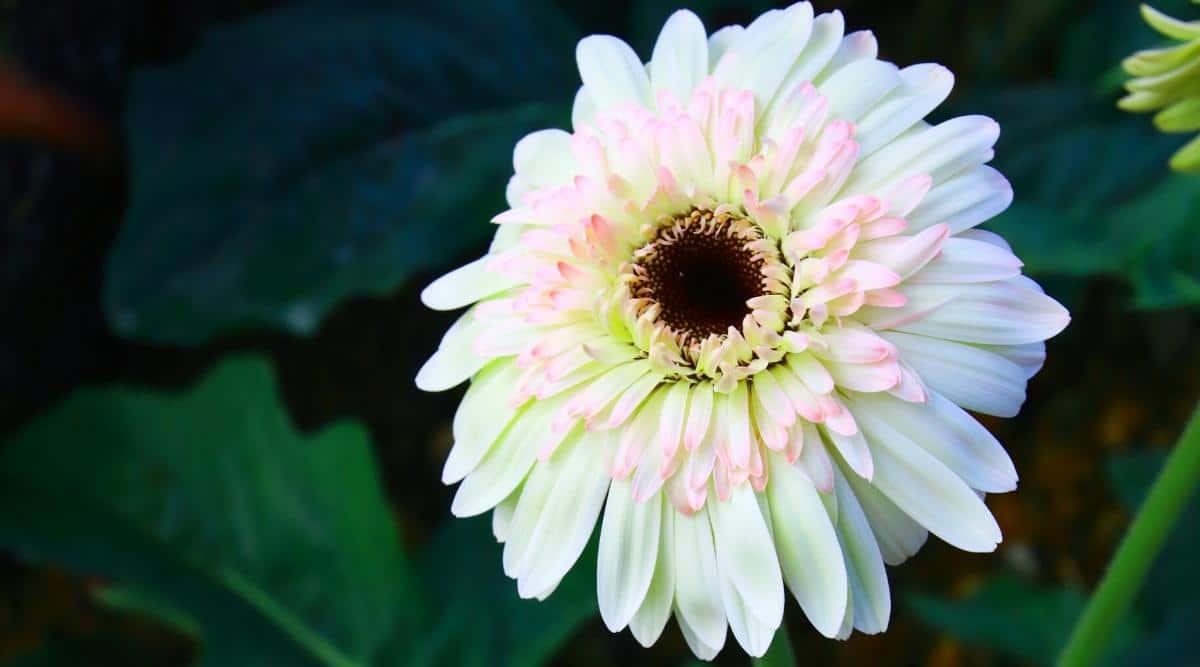
Scientific Name: Gerbera
- Plant Type: Herbaceous Perennial
- Geographic Origin: South Africa
- Plant Size: 6-18 in tall
- Sun Exposure: Full sun, Partial Shade
- Plant Zone: 8 to 10
Gerbera daisies are semi-evergreen perennials that make lovely flowers much larger than the common daisy. Gerbera daisy flowers are usually two inches across and bloom throughout spring and summer into fall.
This plant stands at eighteen inches tall and enjoys full and partial sun as well as chalky, loam, and sandy soils. It needs to be in a place with good drainage.
Gerbera daisies rarely have problems but can acquire root rot, leaf spots, mildew, whiteflies, leaf miner, and aphids.
These flowers do well in colder climates and produce lush, dense foliage.
Gooseneck Loosestrife

Scientific Name: Lysimachia clethroides
- Plant Type: Perennials
- Geographic Origin: East Asia
- Plant Size: 2-3 ft. tall, 2-4 ft. wide
- Sun Exposure: Full Sun, Partial Sun
- Plant Zone: 3 to 8/9
Gooseneck loosestrife is a unique perennial that forms curved stalks of flowers in the shape of a gooseneck. The so-called necks are about twelve to eighteen inches long, and the plant itself reaches a height of two to three feet.
Gooseneck loosestrife has a spread of two to four feet and prefers full and partial sun. It takes little outside care and can grow in any soil but prefers wetlands, riverbanks, and bog gardens. It rarely has pests or diseases and can tolerate wet soil, deer, and rabbits.
This plant flowers in summer and lasts until fall. It should be trimmed after blooming.
Heliotrope
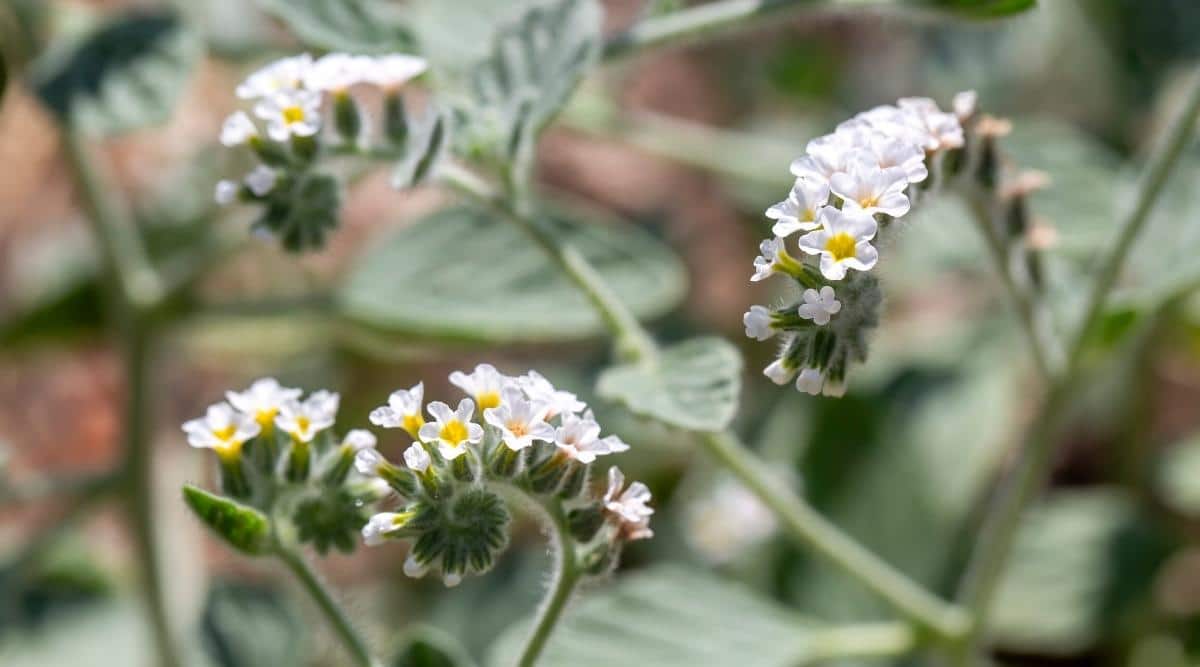
Scientific Name: Heliotropium
- Plant Type: Annual
- Geographic Origin: Bolivia, Colombia, and Peru
- Plant Size: 1-3 ft
- Sun Exposure: Full Sun
- Plant Zone: 9 to 10
The heliotrope plant is a perennial that loves full sun exposure and blooms throughout spring and summer and into fall. It stands twelve to eighteen inches high and produces many flowers along its stems as they unfurl, making it attractive to butterflies.
The heliotrope is toxic if ingested. It reproduces through seeds and far-reaching roots. This plant can get out of hand, especially in agricultural environments, as it is fast spreading and needs little to no maintenance and very little water. It also doesn’t face many diseases or pest problems.
Heliotrope prefers dry sandy and loam-type soils but will still grow in wet environments. It is native to North and South America.
Hellebore
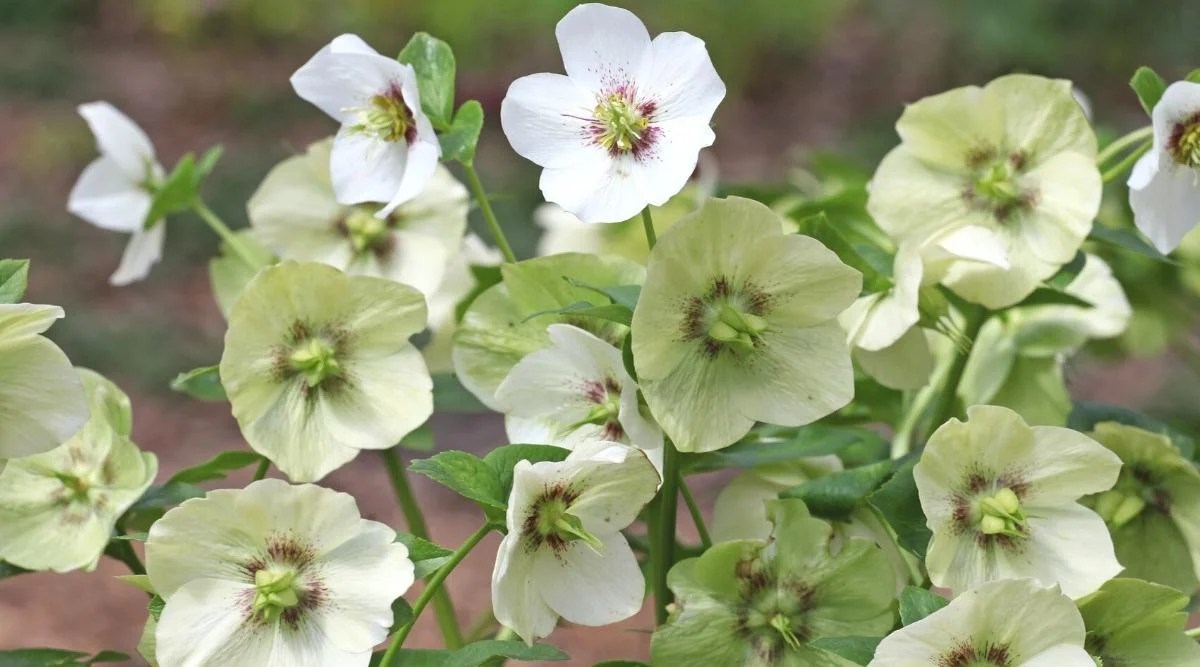
Scientific Name: Helleborus
- Plant Type: Herbaceous Perennial
- Geographic Origin: Southern and Central Europe
- Plant Size: 1-2 ft. tall
- Sun Exposure: Full Sun, Full Shade, Partial Shade
- Plant Zone: 6 to 9
The hellebore, usually called Potter’s wheel or Christmas rose, is a perennial flower that famously blooms from late winter to early spring.
This stout plant grows in a cluster of twelve to eighteen inches high and fifteen to eighteen inches wide. The short, straight stems produce one flower each, measuring three inches in diameter.
Hellebore grows well in partial sun and shady conditions and will self-seed in chalky, clay, and loam soils. It also likes moist, well-drained areas and needs shelter from harsh winds.
The hellebore plant doesn’t have any problems with pests or diseases and can even stand up to deer. Do not eat it and be wary of possible skin irritation.
Hibiscus

Scientific Name: Hibiscus Moscheutos
- Plant Type: Perennial
- Geographic Origin: Asia and the Pacific islands
- Plant Size: 3-7 ft tall
- Sun Exposure: Full Sun
- Plant Zone: 5 to 8
The robust hibiscus is a perennial shrub that stands between three and seven feet. It spans two to four feet and revels in direct sun exposure. The hibiscus flowers from the middle of summer through fall, opening new buds every day to replace the ones that die off.
This plant attracts hummingbirds and butterflies and can tolerate both drought and wet soil. It is generally disease and pest-resistant but can be prone to beetles, blights, canker, rust, and leaf spots.
Hibiscus plants like wetter soil near streams and bodies of water and will grow in marshes, swamps, meadows, wetland woods.
This plant grows in clay and loam soils and will grow in gardens and large pots.
Hydrangea
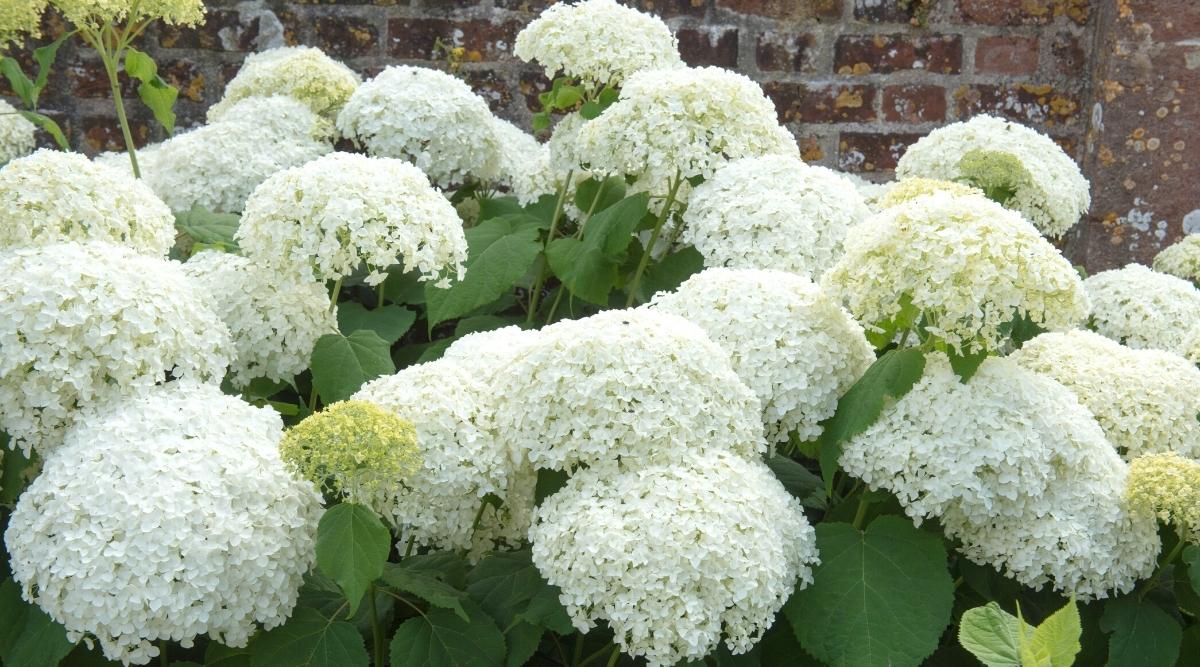
Scientific Name: Hydrangea Aborescens
- Plant Type: Deciduous Shrub
- Geographic Origin: Asia, Americas
- Plant Size: 3-5 ft tall
- Sun Exposure: Full Morning Sun, Afternoon Shade
- Plant Zone: 3 to 9
Hydrangeas grow in dense clusters full of hundreds of tiny flowers. These shrubby bundles stand about three to five feet high and wide. The flower clusters are roughly six inches across.
This plant boasts large bright leaves and many thousands of flowers. It blooms throughout summer and into fall and enjoys full and partial sun. Hydrangeas will grow in clay, loam, and sandy soil so long as it is moist and well-drained.
Hydrangeas should be pruned in late winter or early spring and propagate through seeds or cuttings. They are prone to bud blight, bacteria wilt, rust, mold, mildew, leaf spots, aphids, mites, scale, and nematodes.
Lily
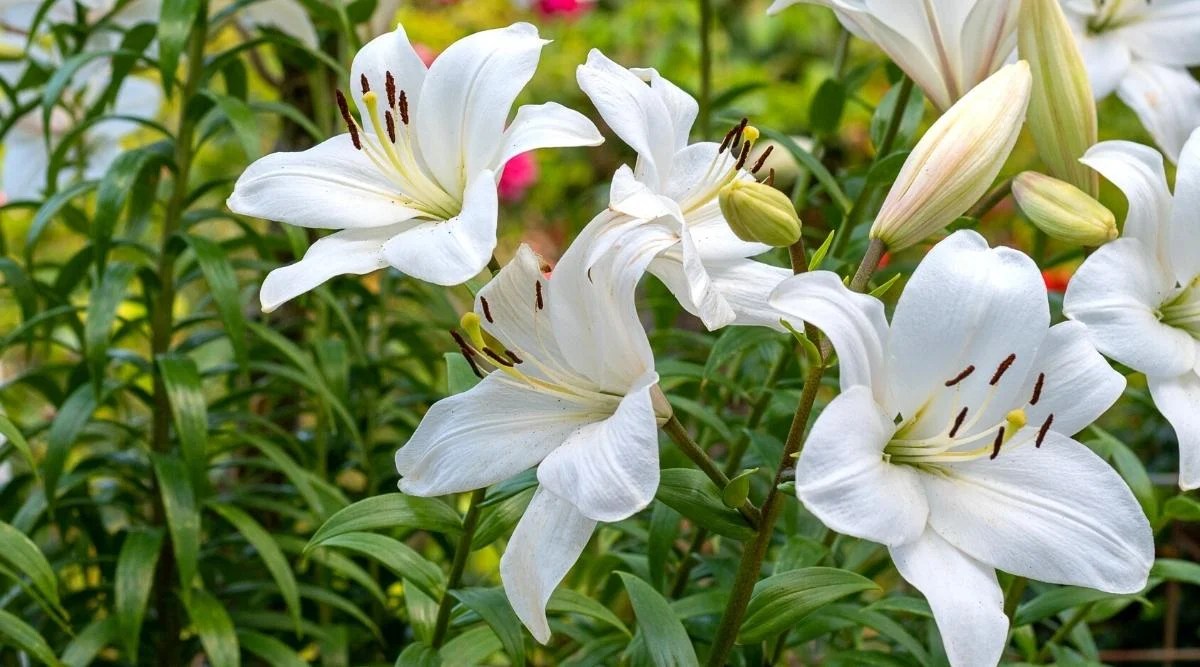
Scientific Name: Lilium
- Plant Type: Bulbous Perennials
- Geographic Origin: Europe, Asia and North America
- Plant Size: 1-3 ft / 3-8 ft
- Sun Exposure: Full Sun
- Plant Zone: 4 to 9
Lilies are a staple piece in any garden. They flower in mid and late summer and produce a heavenly scent. Lilies grow in chalky, sandy, clay, and loam soils, so long as there is adequate water and drainage. They like full and partial sun and take very little maintenance.
Lilies stand at three to four feet tall and make six to eight flowers per stem. Plant three, six, or twelve bulb sets for the best visuals.
Lilies attract bees and butterflies but are toxic for cats; they also resist rabbits and deer well. Lilies can grow almost anywhere and have little trouble with disease or pests. Plant them in fall or early spring and trim them back after bloom.
Lily of the Valley
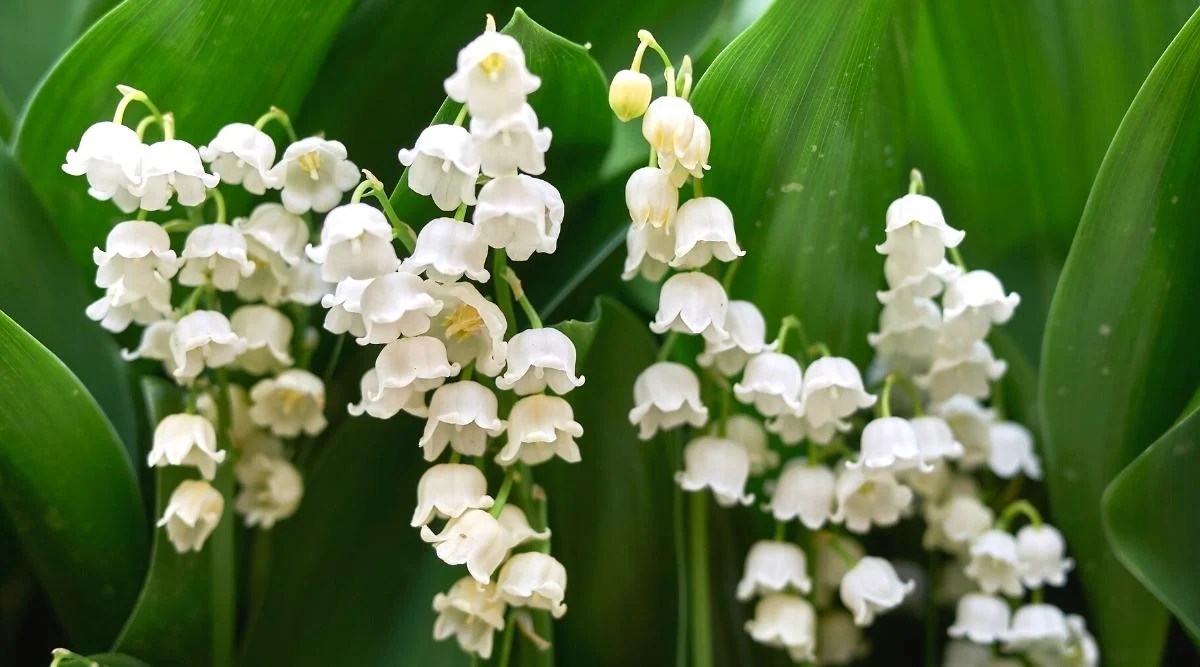
Scientific Name: Convallaria Majalis
- Plant Type: Perennial
- Geographic Origin: Japan
- Plant Size: 6-12 in tall, 9-12 in wide
- Sun Exposure: Partial, Full Sun
- Plant Zone: 2 to 9
The lily of the valley plant is a stunning addition to any garden. It stands a mere six to twelve inches high and makes many tiny white bell-shaped flowers. Lily of the valley has a sweet scent and takes very little effort to maintain.
This plant likes clay and loam soils that are on the wetter side but still have good drainage. However, they can tolerate dry soil, clay, and deer. They also grow best with a yearly sprinkling of organic compost.
Lily of the valley is toxic if ingested and invasive in some areas of North America. It propagates through seed and looks lovely in arrangements.
Lobelia

Scientific Name: Lobelia
- Plant Type: Tender Perennial
- Geographic Origin: North America, Europe and Asia
- Plant Size: 6-9 in
- Sun Exposure: Full Sun, tolerates Partial Shade
- Plant Zone: 10 to 11
Lobelias are perennials native to North America that bloom at the end of summer and into fall. They like full and partial sun and will grow in chalky, loam, sandy, and clay soils. They need lots of water but little maintenance.
Lobelia is a favorite of hummingbirds, bees, and butterflies. It is a very hardy plant and will grow two to three feet tall and spread twelve to eighteen inches. They grow in bog gardens, by streams, and in marshy wetlands.
Lobelias promote proper insect life and are resistant to deer and rabbits. They rarely have disease or pest issues and shouldn’t be ingested.
Magnolia Flower
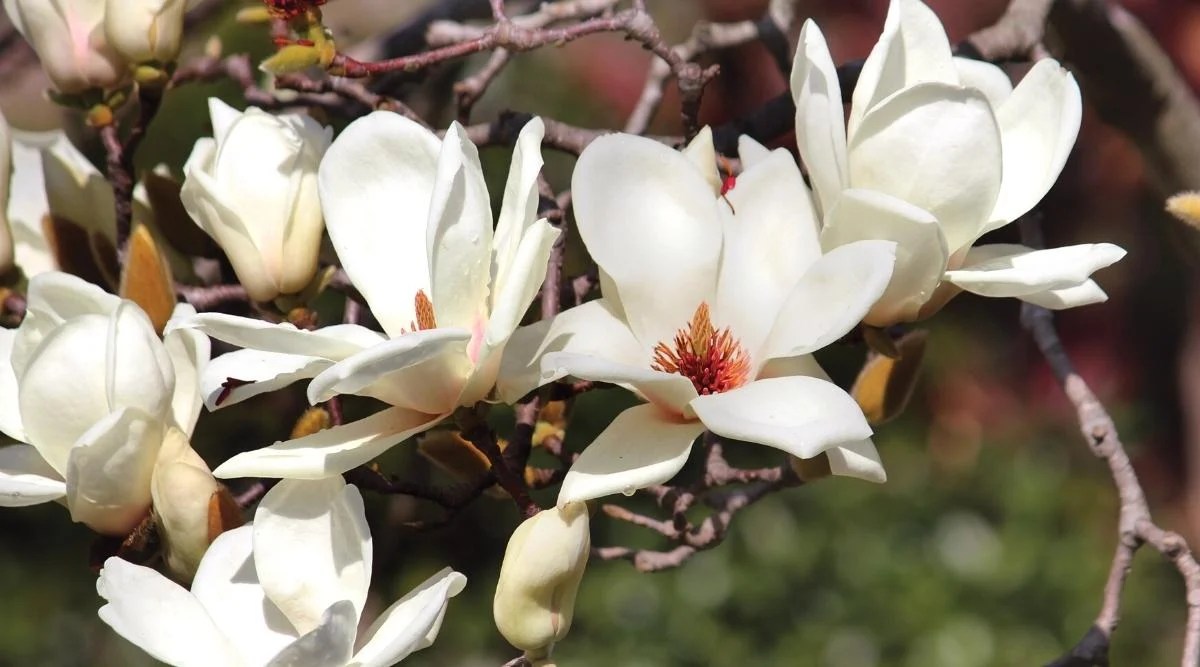
Scientific Name: Magnolia Denudata
- Plant Type: Shrub, Tree
- Geographic Origin: China
- Plant Size: 30-40 ft
- Sun Exposure: Full Sun, Partial Sun
- Plant Zone: 5 to 9
The magnolia tree is renowned for its beauty. Flowering in late winter into early spring when the branches are still bare, this plant brings new life to any garden. While the three-inch flowers are lovely, the tree can span thirty to forty feet high and wide.
This white flowered tree grows in clay, loam, and sandy soil that is moist but has good drainage. It also attracts birds and butterflies. Magnolias love sunlight and don’t require much care. They should be pruned of dead blossoms in summer and kept sheltered from harsh winds.
Mock Orange

Scientific Name: Philadelphus
- Plant Type: Deciduous Shrubs
- Geographic Origin: Northern Italy, Austria, and Central Romania
- Plant Size: 10-12 ft. tall
- Sun Exposure: Full Sun, Partial Sun
- Plant Zone: 4 to 7
The mock orange is a small and round deciduous shrub that is famous for its very potent scent. The shrub is covered in flowers from late spring to early summer and enjoys full and partial sun. This plant will grow in any moderately wet soil, and it can tolerate clay soils and rabbits.
The mock orange can grow ten to twelve feet in height and just as much wide. The flowers are only an inch in diameter.
Mock oranges have little trouble with pests and disease but can have problems with canker, leaf spot, and mildew.
Moonflower
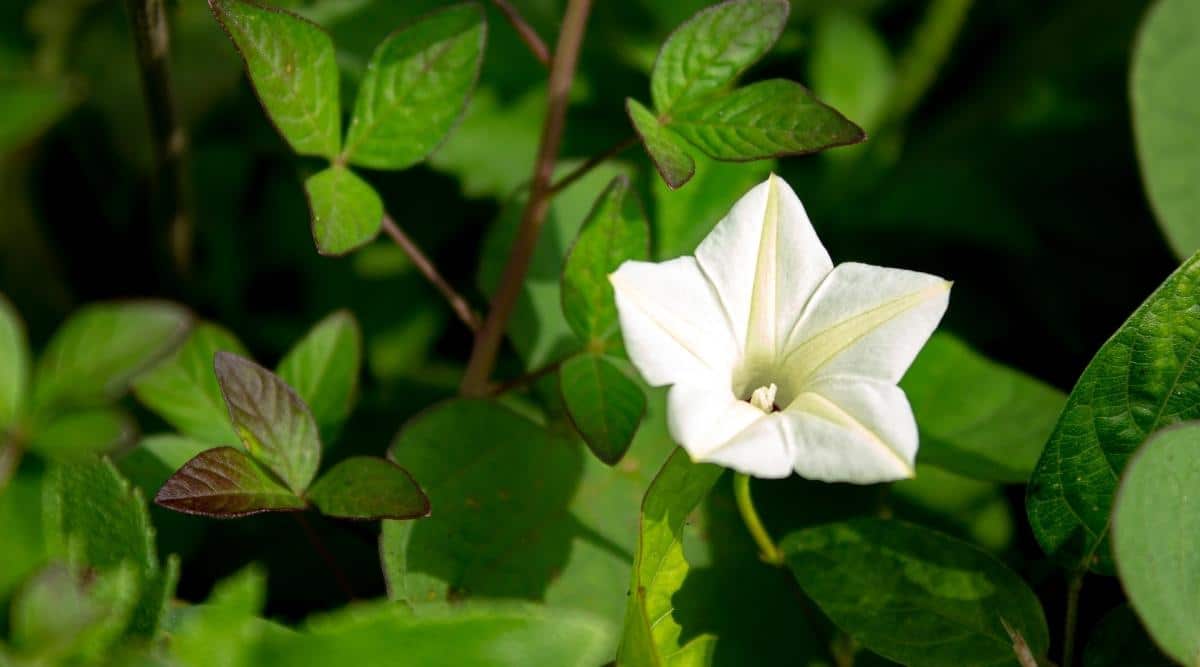
Scientific Name: Ipomoea Alba
- Plant Type: Perennial flowering vines
- Geographic Origin: Tropical Americas
- Plant Size: 20 feet long
- Sun Exposure: Full
- Plant Zone: 10 to 12 (USDA)
The moonflower is a climbing perennial that can reach heights of ten to fifteen feet. The flowers are three to six inches across and bloom in the morning from mid-summer to the end of fall.
Moonflowers are fragrant, deer resistant, and have essentially no issues with pests or disease. These flowers love full sunlight and moist earth. They are fast-growing and should not be eaten. Propagate through seeds indoors and then move outside after the frost has passed.
Nemesia

Scientific Name: Nemesia
- Plant Type: Annual
- Geographic Origin: South Africa
- Plant Size: 12-20in
- Sun Exposure: Full Sun, Partial Sun
- Plant Zone: 9 to 11
Nemesia grows six to twelve inches tall and wide and produces many hundreds of flowers in each bloom. They are fragrant and low-maintenance plants that enjoy full and partial sun. Nemesia does well in cooler climates and needs more shade in hotter ones.
This plant propagates through seeds and cuttings and likes moist and well-drained soil. They flower less in hotter climates and should be fertilized after being cut back.
This plant can be pruned for shape and makes lovely arrangements.
Nicotiana

Scientific Name: Nicotiana
- Plant Type: Herbaceous perennial
- Geographic Origin:
- Plant Size: 3-5 ft tall, 1-2 ft wide
- Sun Exposure: Full sun to Partial shade
- Plant Zone: 9 to 10
Nicotiana is a flowering tobacco plant with a strong scent and a low maintenance schedule. These plants make five-inch long flowers and can grow up to one to three feet high. They are versatile and like sun or shade.
Nicotiana self-propagates through seeds and is attractive to hummingbirds, butterflies, and pollinating insects. It grows in chalky, loam, and clay soils with good drainage and works in almost any type of garden. The nicotiana plant blooms in summer and fall.
Peony

Scientific Name: Paeonia Lactiflora
- Plant Type: Herbaceous perennial
- Geographic Origin: Asia, Europe and Western North America
- Plant Size: 2-3 ft tall
- Sun Exposure: Full Sun
- Plant Zone: 3 to 8
The peony can have white blooms, and flowers from late spring to early summer. They love sunlight and need moist, well-drained soil of any type.
Peonies are excellent in the garden, in pots, and indoors. They are deer and rabbit resistant and will bring in butterflies. Peonies grow up to thirty inches tall and twenty-four to thirty-six inches wide. The flowers are two to three inches across.
Peonies require little maintenance and rarely have issues with diseases or pests. They also live quite long and should not be eaten.
Periwinkle

Scientific Name: Catharanthus Roseus
- Plant Type: Herbaceous perennial
- Geographic Origin: Madagascar
- Plant Size: 6-18 in.tall
- Sun Exposure: Full Sun, Partial Shade
- Plant Zone: 11 to 12
Periwinkles are small, low-lying perennials that only reach four to six inches in height but can have a spread of twenty-four to thirty-six inches. This plant likes any amount of sun or shade and moist soil but can handle dry and even drought conditions.
Periwinkles don’t encounter many pest or disease problems and don’t need much outside care. This flower blooms in spring, summer, and fall and provides excellent evergreen ground coverage. It is also resistant to deer and rabbits and can grow in rocky conditions too.
This plant is an invasive species in some areas and attracts butterflies.
Petunia

Scientific Name: Petunia
- Plant Type: Nightshade
- Geographic Origin: South America
- Plant Size: 6-18 in
- Sun Exposure: Full Sun
- Plant Zone: 9 to 11
Petunias are annual flowers that grow in mound formation. They flower from late spring to fall and stand at six to twelve inches tall and thirty to forty inches wide.
This plant likes sunny spaces and a bit of shade as well as moist, well-drained soil. They can grow in any soil and propagate by seed. Look out for aphids, slugs, snails, root rot, and mold.
Petunias usually need little maintenance but benefit from removing dead blooms and the occasional trim.
Phlox
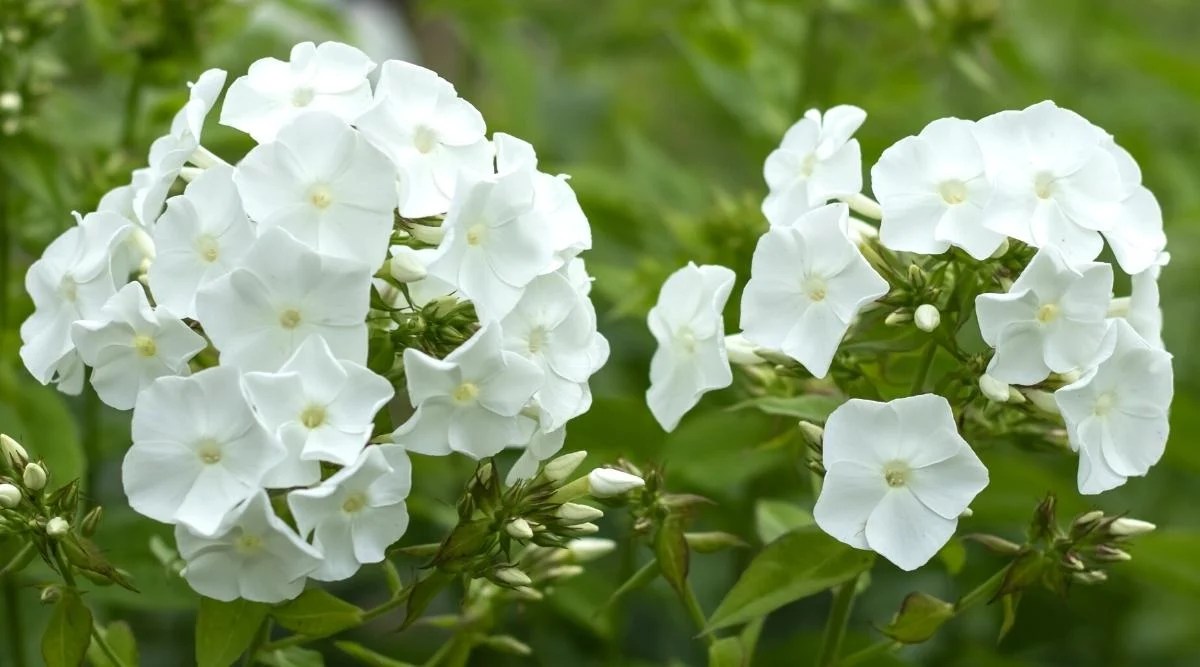
Scientific Name: Phlox
- Plant Type: Herbaceous perennial
- Geographic Origin: American
- Plant Size: 2-4 ft tall
- Sun Exposure: Full Sun
- Plant Zone: 4 to 8
Phlox is a summer flower that likes the sun and a bit of shade. It grows well in chalky, loam, and clay soils and is resistant to deer.
Phlox flowers form in dense groups, and the plant can stand at three to four feet high. This plant likes cool air and is attractive to hummingbirds and butterflies. It is also remarkably resistant to molds and mildew. They look good as single plants and in groups.
Phlox is self-seeding and has a sweet fragrance. It livens up any garden.
Profusion Salvia

Scientific Name: Salvia Salvia Nemorosa
- Plant Type: Herbaceous Perennial
- Geographic Origin: Europe, West-central Asia
- Plant Size: 20 in high
- Sun Exposure: Full Sun
- Plant Zone: 3 to 8
The profusion salvia plant is a fragrant bush that makes tall stalks of white flowers. It likes full sun and grows one to two feet high. It requires very little maintenance and little water.
This plant has a full, bushy look and blooms throughout the summer and into fall. It attracts hummingbirds, bees, and butterflies and tolerates deer, drought, dry soil, and rocky ground.
Profusion salvia is easy to grow and helps to fill out gardens. It should be cut back after flowering.
Sweet Alyssum

Scientific Name: Lobularia Maritima
- Plant Type: Annual
- Geographic Origin: Southern Europe
- Plant Size: 2–12 in tall
- Sun Exposure: Full Sun, Partial Shade
- Plant Zone: 2 to 11
Sweet alyssum is a robust plant that can stand up to droughts, dry soil, and arid areas. The overwhelming blooms flower from late spring until winter frost.
While it can put up with a lot, this plant’s ideal conditions are in chalky, loam, or sandy soil that has good drainage. It also likes full and partial sun. It will attract butterflies and can withstand deer.
In some areas, this plant is invasive. Regular shearing and fertilizing help its growth.
Tulip
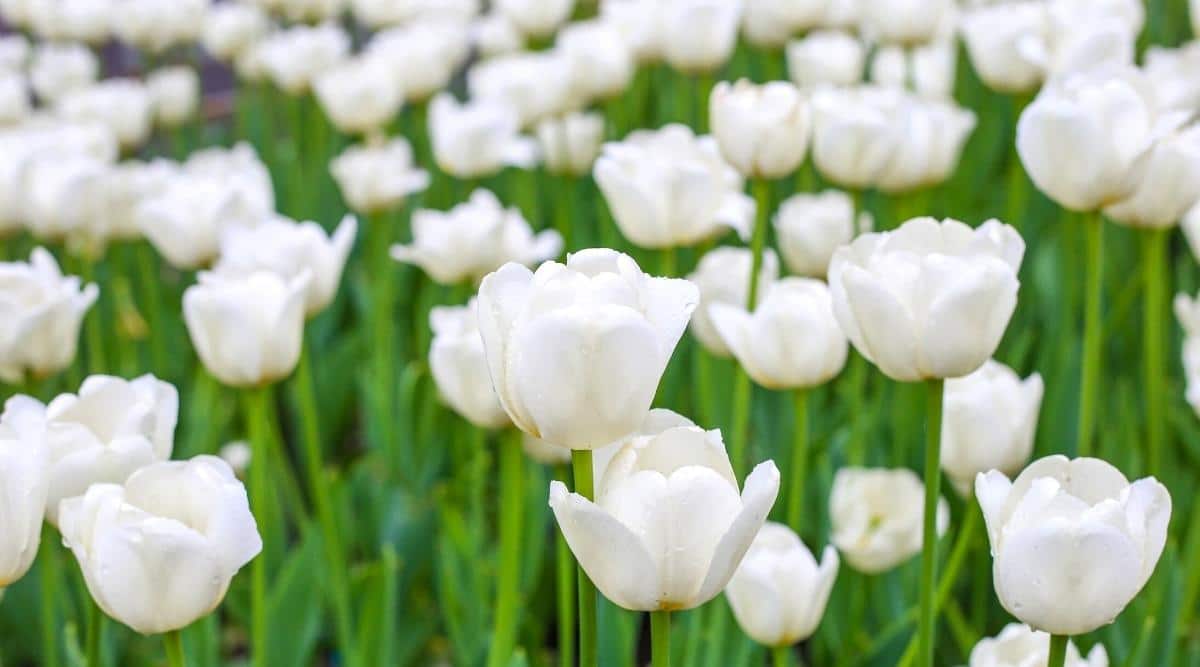
Scientific Name: Tulipa
- Plant Type: Perennials
- Geographic Origin: Southern Europe to Central Asia
- Plant Size: 4-28 in high
- Sun Exposure: Full Sun
- Plant Zone: 3 to 8
Tulips love full, direct sunlight and will flower in mid to late spring. They stand at around ten inches tall and have very straight single stems.
Tulips require little outside care and like chalky, loam, and sandy soils. They are some of the nicest flowers for arrangements and can grow in gardens, pots, and indoors. Plant the bulbs in the fall. Tulips prefer dry summers that are not too hot and cold winters.
Virginia Sweetspire

Scientific Name: Itea Virginica
- Plant Type: Deciduous Shrub
- Geographic Origin: Eastern United States
- Plant Size: 8ft
- Sun Exposure: Full Sun, Partial Sun, Shade
- Plant Zone: 4 to 6
Virginia sweetspire is a unique shrub that produces long tendrils of white flowers. It stands at three to ten feet and just as wide. Virginia sweetspire likes any amount of sun or shade and has a sweet fragrance. It is also semi-evergreen.
This plant grows in clay and loam soils and rarely has problems with pests or disease. It should be pruned after flowering and can be shaped as a hedge or left as a bush. It flowers from mid-spring through fall.
White Buttercup

Scientific Name: Ranunculus Aquatilis
- Plant Type: Perennial aquatic plant
- Geographic Origin: Europe and western North America, and also northwest Africa.
- Plant Size: 1-6 in. above water
- Sun Exposure: Full Sun
- Plant Zone: 5 to 8
White buttercup is a submerged evergreen perennial that grows in large patches and produces many small flowers. It only reaches about two inches but spreads twelve to twenty-four.
White buttercup loves full sunlight and wet, marshy soil. It will grow in shallow ponds and areas with poor drainage. It needs a lot of water but doesn’t require much maintenance and rarely has issues with pests or disease.
White buttercup flowers from mid-spring until the end of summer. It’s a great way to fill in a water garden. It is native to North America.
White City Spanish Bluebells

Scientific Name: Hyacinthoides Hispanica
- Plant Type: Bulbous Perennials
- Geographic Origin: Spain, Portugal and northwest Africa
- Plant Size: 12-15 in
- Sun Exposure: Full Sun, Partial Sun
- Plant Zone: 3 to 8
White city Spanish bluebells are beautiful flowers with a long, elegant appearance. They stand at twelve to fifteen inches tall with long leaves and slender stems topped with small arrangements of white flowers.
This plant likes any type of soil so long as it is moist and well-drained and has access to full or partial sun. The flowers bloom in mid to late spring and are resistant to rabbits, deer, drought, and dry soil.
This plant can grow in gardens, pots, and indoors. They look lovely cut and in arrangements, as well.
White Lavender
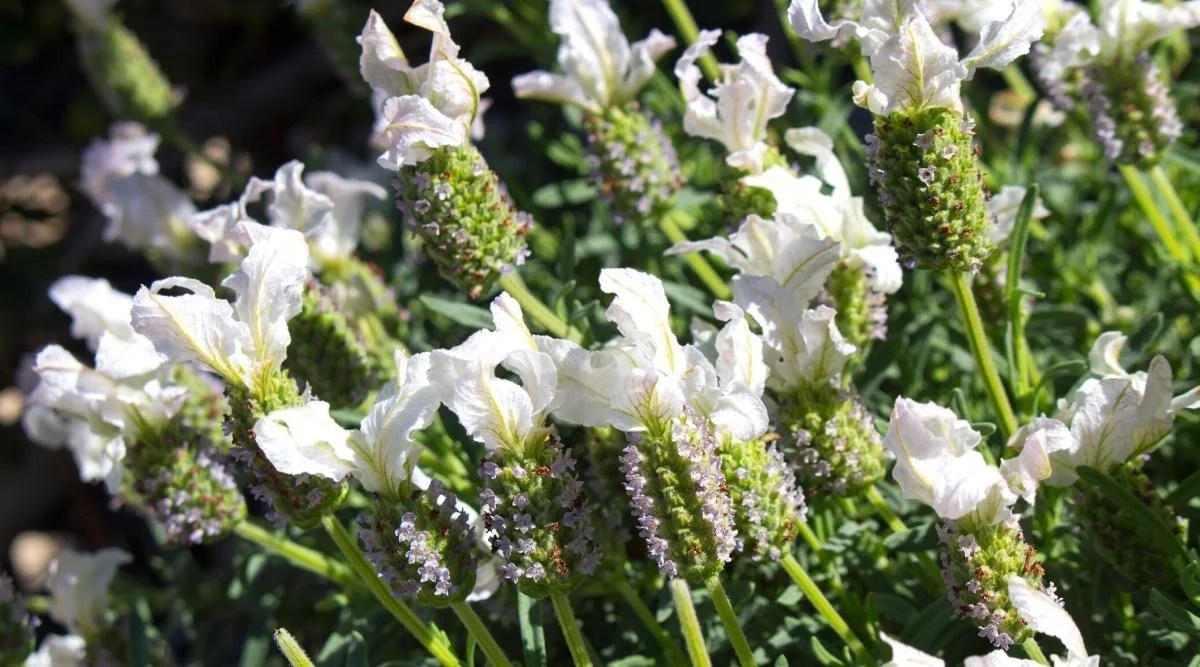
Scientific Name: Lavandula Angustifolia
- Plant Type: Herbs, Perennials, Shrubs
- Geographic Origin: Mediterranean
- Plant Size: 2-3 ft. tall
- Sun Exposure: Full Sun
- Plant Zone: 5 to 9
White lavender is a rare sight but beautiful to behold. Most white lavender varieties are part of the five main lavender types that gardeners grow. White lavender has the same bold fragrance and looks. The stalks stand at twenty to twenty-four inches and grow in clumps twenty-four to thirty inches wide. Lavender blooms from late spring to the middle of summer.
This plant likes full sun and well-drained soil. It can grow in drought, dry, and rocky conditions. It is also resistant to deer and rabbits and will attract butterflies and pollinators. White lavender should be trimmed in spring for new growth.
White Rose

Scientific Name: Rosa X Alba
- Plant Type: Deciduous shrub
- Geographic Origin: Europe
- Plant Size: 6-9 ft
- Sun Exposure: Full sun to Partial shade
- Plant Zone: 3 to 8
The white rose is one of the most stunning. It stands at six to eight feet, with flowers reaching six or seven inches across. They are very fragrant white perennial flowers that bloom from late spring to early summer.
White roses like sunlight but are shade tolerant and like clay, loam, and sandy soils with occasional fertilizer or compost. The cuttings look lovely, and propagation is done through cuttings.
Wisteria
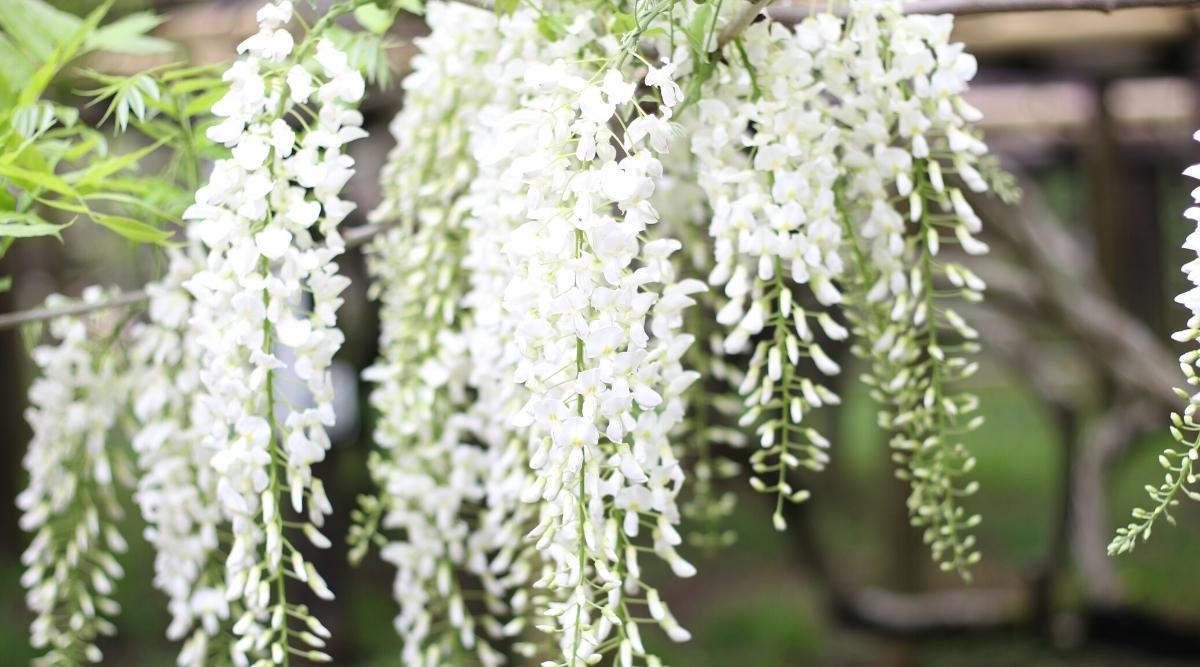
Scientific Name: Wisteria
- Plant Type: Perennial
- Geographic Origin: Asia and North America
- Plant Size: 10-30 feet
- Sun Exposure: Full Sun, Partial Shade
- Plant Zone: 5 to 9
Wisteria is a truly magical-looking plant. Sometimes called lavender lace, this tree has long, hanging tendrils of silky flowers like a willow. The tree can grow anywhere from ten to thirty feet and spreads just as wide.
Wisteria likes full and partial sun and grows in any moist and well-drained soil. It is fragrant and attractive to butterflies and fairs well with deer and in drought.
This plant is invasive in parts of Northern America and shouldn’t be eaten. It also dislikes transplanting.
Wrapping Up
While there is a nearly endless number of white flowers to choose from, these are some of the most stunning. There are many different types of flowers you can plant, from annuals to perennials, and white is one of the most popular flower colors in most home gardens. Whether you’ve decided on dahlias, or roses, there is something for just about every gardener. Make sure you take your hardiness zone into accountability and start experimenting with these white blooms in your garden this season!